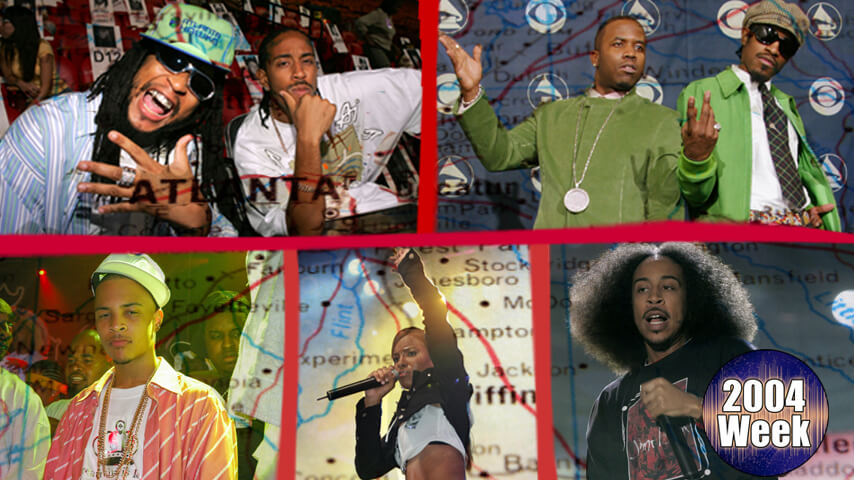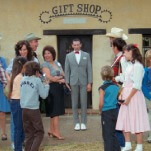In the early ’90s, Atlanta’s hip-hop and R&B sound was known for largely borrowing elements of Miami bass music, which fueled the Southern party scene with notably upbeat tempos and persistent kick drums. Despite having to remain scrappy in an industry saturated with acts from New York and Los Angeles, Atlanta’s music scene managed to break through the noise early on with a few runaway hits, including TLC, Arrested Development’s “Tennessee” and Kris Kross’s “Jump” (all Grammy winners) and the inescapable “Whoomp! There It Is” from platinum-selling group Tag Team. Soon, a more distinct sonic identity would surface with the help of production duo Organized Noize and late producer Rico Wade, all of whom are credited as major architects of the funk and soul-infused sound that underscored much of Outkast’s discography and built the powerful Atlantan collective, the Dungeon Family. At the top of 2004, Outkast secured two No. 1 hits with the infectious “Hey Ya!” and “The Way You Move,” which reached top status on Jan. 3 and Feb. 14, respectively. That year, the duo was recognized on the Time 100 list, where they were praised for having two songs enter the top of the pop charts simultaneously—the first group to do it since the Beatles accomplished as much 40 years prior.
While Outkast ruled the world with funk-laced bops, Lil Jon quickly became known as the go-to collaborative force behind crunk music, turning charged synths, 808 baselines, and addicting call-and-response choruses into his in-demand calling card. As a respected DJ and the front man of the Eastside Boyz, Lil Jon was already a nightclub fixture with hits like “Bia Bia,” “I Don’t Give A Fuck,” and the legendary “Get Low” under his belt. But as a producer, he was an absolute necessity. For other artists, linking with Lil Jon equaled club scene legitimacy, and top acts like Pitbull, Petey Pablo, and Ice Cube reaped the chartworthy benefits.
But it was the King of Crunk’s collaboration with fellow Atlantans Usher and Ludacris that was arguably his most successful creative feat of 2004. “Yeah!” was a mainstream phenomenon that quickly asserted itself as a club staple (and had everyone doing the ATL Stomp, regardless of whether or not they’d ever even visited the city). Anthemic and prickling with sexual energy, “Yeah!” had everything, from Usher’s flirtatious croon, to Lil Jon’s menacing interjections, to an engaging, confident Ludacris guest verse. The track was the cherry on top of a banner year for Usher, as well, as it served as the R&B maestro’s leading single off of his critical album Confessions and claimed the top spot of Billboard’s Top 100 list for 12 consecutive weeks (before getting dethroned by the album’s second single, “Burn”). It was later crowned by Billboard as the top song of 2004—a list that also held three other Usher tracks, including “Burn,” “Confessions Part II,” and his duet with Alicia Keys, “My Boo.”
For Lil Jon, “Yeah!” was a trophy of sorts, a grand payoff for his ability to not only produce an absolute banger, but also successfully blend crunk music with the often much smoother R&B. The feat was significant enough for him to coin the genre “Crunk&B” to describe tunes like “Yeah!” and his 2004 collaboration with Atlanta songstress Nivea, “Okay.” While the catchiness of the term is debatable, the legitimacy of the regional music that anchored the category into the pop culture zeitgeist was not. Atlanta-made R&B singer-songwriter Ciara became another Lil Jon success story that year with her debut single, “Goodies.” Although its prevailing theme of abstinence made it the lyrical antithesis of “Yeah!,” it still garnered a lot of comparisons from music critics, thanks to its similarly synth-fueled chorus, upbeat tempo, and prevailing pop appeal. “Goodies” was also Billboard charts mainstay that year, peaking at No. 1 on the Billboard Hot 100 chart for seven straight weeks—the longest run top-spot residency for a debuting female artist since 1997. It began a noteworthy inaugural year for Ciara, who also saw major international success with 2004 self-titled debut album and its remaining two single releases, “Oh” and “1, 2 Step.”
And then, of course, there was trap music. Originating in Atlanta, trap operated as the South’s answer to gangster rap by illustrating life and drug dealing in trap houses. Synths and 808 beats remained a major part of the music’s fabric, but the addition of orchestral strings really put trap music in its own lane and, more importantly, hip-hop’s malleability on display. By 2004, trap had gained mainstream popularity thanks to one of its biggest pioneers T.I., whose sophomore album, Trap Muzik, helped position the genre directly on the charts and into the global music fan’s consciousness. 2004 yielded notable crossover success for the Atlanta rapper. On top of releasing his third studio album, Urban Legend, which featured lead single and top-ten Billboard hit, “Bring ’Em Out,” T.I. landed a major feature with Destiny Child’s “Soldier,” a Southern hip-hop-fueled single that extolled the benefits of a street-hardened man. Alongside fellow featured rapper Lil Wayne, T.I.’s involvement added an edge that was necessary and on-theme. It also cemented the mainstream pop appeal of the trap sound T.I. helped cultivate.
Throughout 2004, Atlanta delivered hit after enduring hit. Crime Mob unleashed its undeniable fight-ready classic, “Knuck If You Buck.” Ludacris capped the year with his fifth studio album, The Red Light District, which peddled beloved tracks like “Get Back” and “Number One Spot.” Even CeeLo Green’s 2004 collaboration with Timbaland, “I’ll Be Around,” saw a recent resurgence on TikTok as the official soundtrack for a dance challenge featuring the Baltimore strut. From a high level, Atlanta’s music spans across too many genres and influences to have a singular sound ascribed to all of the city’s pop cultural offerings, but if 2004 confirmed anything, it’s that whenever the city had something to say, the world was more than ready to listen.









































